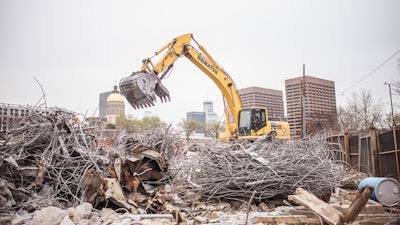
Information from this article was first published in Demolition Magazine and is being reused with permission from the National Demolition Association.
By Alexa Scholsser
Local Atlantans knew the Georgia Archives Building as the “White Ice Cube” because, well, it looked like one. The 18-story marble structure stood near the city’s four major highways and was the official repository of archival records for the State of Georgia starting in 1965. Its collections included the founding documents of the state, such as the Royal Charter that created the colony of Georgia in 1733, and the Ratification of the United States Constitution, which designated Georgia as one of the original 13 colonies.
Although the building was recognized as the most modern archival facility in the country, in 1998, engineers discovered that the White Ice Cube was sinking due to groundwater and nearby interstate construction. The building was also in need of costly HVAC system repairs, and it was ultimately determined that new construction was the most viable option. It was closed permanently in 2012 and earmarked for demolition and implosion.
NDA member SSD Demolition and Environmental (SSD) was chosen to perform the asbestos abatement and demolition of four stories underground and 14 stories above ground, totaling approximately 650,000 square feet, as well as the implosion.
Planning an community involvement
SSD — a CVE-certified service disabled veteran owned small business and a Georgia DBE/MBE minority-owned company — was the first contractor on-site, and because of the scope and location of the job, the eyes of the city, county, state and surrounding community were watching closely. During the planning phases of the project, which occurred over six months, SSD held several meetings to educate the surrounding community on implosion procedures, impacts, safety and knowledge of the company’s previous implosion experiences.
“We took our responsibility for community involvement very seriously,” says Michael Gorman, president of SSD. “The demolition portion of the project was an ‘open book’ for the community and was instrumental in garnering and maintaining community support, including an implosion-day breakfast and party for area neighbors and friends as a thank you for their involvement in the process.”
Abatement, demolition and implosion
 A total of 1,800 holes were drilled throughout six designated blast floors and 600 pounds of explosives were used inside the building.
A total of 1,800 holes were drilled throughout six designated blast floors and 600 pounds of explosives were used inside the building.
The implosion occurred on March 5, 2017. A total of 1,800 holes were drilled throughout six designated blast floors. A total of 6,000 feet of concrete saw-cutting took place in order to separate the building walls and floors from structures that remained; 1,500 feet of prima cord and 600 pounds of explosives were used inside the building.
Sustainability and safety
Over the course of the project, SSD removed asbestos-containing material from approximately 250,000 square feet of the 650,000-squarefoot building. It also recycled 8,800 tons of various metals, 59,650 tons of concrete and 4,600 square feet of marble. All of the above volumes represent tonnage diverted from landfill disposal. In total, 98.7 percent of all debris generated by the demolition was recycled.
The efficiencies of scale that occurred during the abatement and demolition phases contributed to the overall sustainability of the project. SSD reused the crushed concrete as fill material to fill the four-story underground parking deck, and the site will become the new State Courts Building that will house the newly expanded Georgia Supreme Court and Georgia Court of Appeals.
“It was vitally important to the State of Georgia that the sustainability of the project began at the demolition and remediation stage of the project,” says project manager Oscar Contreras.
“SSD was selected in large part due to its longstanding reputation for ‘green demolition,’” says Greg Gorman, senior vice president of SSD. “SSD’s innovative approach to asset recovery and recycling was implemented immediately and began the project’s strategic shift from landfill based waste disposal mindset to a ‘reduce, reuse, recycle’ philosophy.”
In addition to sustainability, SSD focused its efforts on having a safe working environment. Site safety was of paramount concern on a project with this many moving pieces. The company added a dedicated third-party safety officer to manage and monitor safety on a daily basis.
“The full-time site safety officer implemented daily, full-site safety meetings and educated our employees on potential hazards during the scope of work,” Greg Gorman says. “SSD operates using a behavioral-based safety bonus program that ties all employee bonus dollars to the overall safety record of each project. The safety bonus program was in full effect on this project and operated at a 100 percent safety record for lack of injuries and safety bonuses.”
Working together
While the implosion of the White Ice Cube lasted only 30 seconds, it represented months and months of planning and hard work among many different groups.
SSD’s early involvement allowed it to create an atmosphere of partnership with all stakeholders and deliver exactly what was promised. Through proper planning, communication and community involvement, SSD was able to ensure a project that ran smoothly and was lauded by the community and the stakeholders as a total success.
“This project was a wonderful example of how the municipality, the community and the contractor can work together early in the project to define roles and set expectations based upon the experiences and the desires of the stakeholders,” Michael Gorman says. “As implosive demolition, this was textbook.”


















